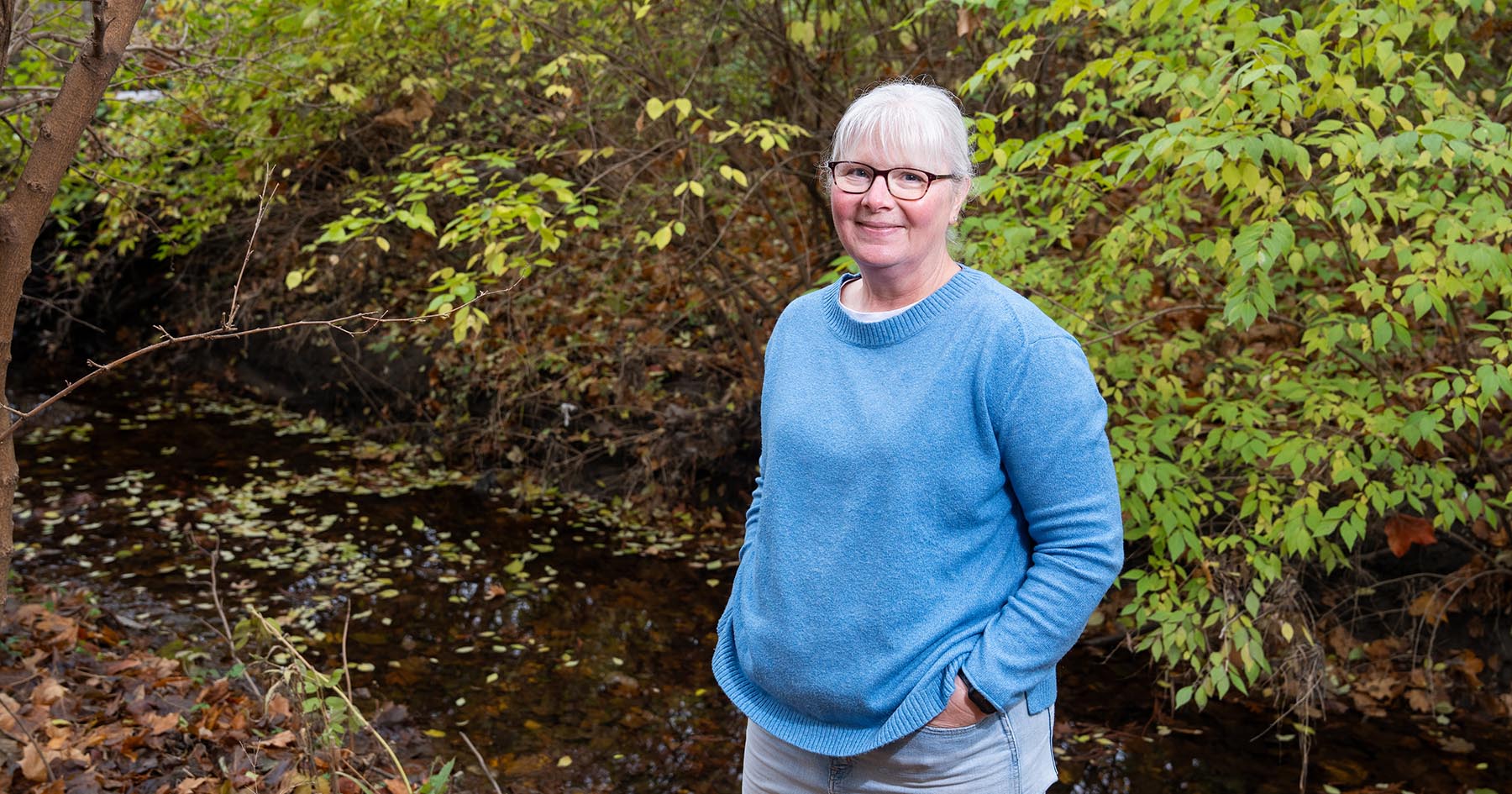Monitoring “forever chemicals” in your favorite fishing holes
Andrew Todd went fishing with his grandfather every summer on Douglas Reservoir in eastern Tennessee. Tyler Hoskins grew up in suburban Indianapolis and rode his bike to fish in nearby subdivisions with retention ponds. Neither imagined fishing would become part of their job, but now these biologists are studying the kinds of ponds many people like to fish in — and whether the fish living in them are safe to eat.
Hoskins, research assistant professor in the Department of Forestry and Natural Resources, has worked on several research projects measuring PFAS in the environment. PFAS, or per- and polyfluoroalkyl substances, are a group of chemicals used to make consumer products heat, water or stain resistant. They are commonly known as “forever chemicals,” because they last in the environment for a long time and are difficult to destroy. They bioaccumulate, or build up in body, and have been detected on every continent and in the blood of most Americans. Studies have linked PFAS to slowed metabolic rates, reduced fertility and fetal growth, increased cancer risk and suppression of immune responses.
One way PFAS work their way into the environment is the application of biosolids, nutrient-rich treated sewage and other biodegradable waste, on agricultural fields. This phosphorus- and nitrogen-rich material has been used as inexpensive fertilizer for decades before scientists realized, in the early 2000s, that it also contained PFAS from industrial, commercial and domestic waste.
Hoskins had seen studies on PFAS levels in the biosolids themselves or soil in agricultural fields but found “there’s just not much out there on what’s happening to water bodies that are receiving runoff from these fields. So that’s a major gap in our understanding of the implications of this practice.”
 Tyler Hoskins, research assistant professor, fishes for samples from a pond on agricultural land with visiting undergraduate students William Brandenburg and Sydney Lehman.
Tyler Hoskins, research assistant professor, fishes for samples from a pond on agricultural land with visiting undergraduate students William Brandenburg and Sydney Lehman. In 2021, using funds from the United States Geological Survey (USGS) administered by the Indiana Water Resources Research Center, based at Purdue, Hoskins and his colleagues conducted a case study of two ponds: one with biosolids runoff and one without. His collaborators include Marisol Sepúlveda, professor of forestry and natural resources , Linda Lee, professor of agronomy, Youn Choi, senior analytical chemist in the Department of Agronomy, and Vicki Blazer and Heather Walsh from the USGS Eastern Ecological Science Center. The research team sampled aquatic plants, invertebrates and as many fish species as they could find and noticed high concentrations of PFAS in the fish samples from the pond with biosolids runoff.
“These things are carrying a lot of different PFAS in their tissues, and pretty high concentrations of some of the more bioaccumulative ones,” Hoskins said. “So we started thinking about how that compares to other types of water bodies that have been sampled more systematically.”
Ponds interested Hoskins in part because they’re understudied — despite how many there are in Indiana and how common they are as fishing spots. Although much of northwest Indiana (and about one quarter of Indiana overall) used to be wetlands, the land was drained to support agriculture. Now many of Indiana’s bodies of water are constructed ponds, including those built for stormwater drainage and flood control in new subdivisions, to water livestock on farms, or simply for aesthetics and enjoyment.
“The other interesting thing about them is they don’t get monitored as part of state and federal water quality or fish contaminant monitoring efforts,” Hoskins said. Agencies like the Indiana Department of Environmental Management (IDEM) and the federal Environmental Protection Agency tend to monitor natural streams, rivers and lakes (which are generally larger and deeper than ponds). Most constructed ponds are on private land, which restricts access for sampling, and often don’t fall under Indiana law as state waters or under the federal Clean Water Act.
 Hoskins secured additional funding from the USGS to expand the case study on PFAS in ponds, and Andrew Todd, a doctoral student in forestry and natural resources, began the work by first using available data to try to determine just how many constructed ponds Indiana has. Over the past month, he’s been knocking on doors trying to find 5 to 10 more sites receiving biosolids runoff to sample this summer. “When we talk to the landowners, there are trends, but it’s definitely different every time,” said Todd. “I mean, I’ve gotten [ponds] anywhere from 80 years old to three years old in the same day.”
Hoskins secured additional funding from the USGS to expand the case study on PFAS in ponds, and Andrew Todd, a doctoral student in forestry and natural resources, began the work by first using available data to try to determine just how many constructed ponds Indiana has. Over the past month, he’s been knocking on doors trying to find 5 to 10 more sites receiving biosolids runoff to sample this summer. “When we talk to the landowners, there are trends, but it’s definitely different every time,” said Todd. “I mean, I’ve gotten [ponds] anywhere from 80 years old to three years old in the same day.”
Their experiments are designed specifically to monitor largemouth bass. “Given that they’re big and they’re predators, they’re going to carry high loads of any PFAS present. They’re kind of telling you what’s going on at lower levels of the food chain, because they’re eating it,” Hoskins said. “And then add that people are commonly eating them, and they’re this really important game fish and recreational sport fish.”
They’ll monitor bass at each site, measuring PFAS levels in their tissue and comparing their data to baseline samples from fish in more frequently monitored rivers and lakes. They’re eager to study the impact of PFAS on the reproductive systems of the fish they’re monitoring, testing the chemicals’ impact on large wild fish by sampling when bass are spawning in the spring.
 Left: Tyler Hoskins, research assistant professor, weighs a fish sample. Right: Visiting undergraduate student William Brandenburg measures a fish sample with help from Purdue doctoral student Andrew Todd.
Left: Tyler Hoskins, research assistant professor, weighs a fish sample. Right: Visiting undergraduate student William Brandenburg measures a fish sample with help from Purdue doctoral student Andrew Todd. 
Todd is also interested in the variation of biosolids and how they’re applied. He has mapped permits for biosolids application and overlaid that on the map of Indiana ponds to identify those within 100 meters of a biosolids application.
“At the end of the day, our data just say ‘biosolids application.’ But there are differences in ponds and differences in biosolids. It’s never simple,” Todd said.
While they plan to publish their results in standard academic channels, they’ll also share them with landowners, who they regularly guide to Purdue Extension’s pond management resources, and IDEM, which contributes to the Indiana State Department of Health’s Fish Consumption Advisory. “For the people who are being kind enough to let us come and sample, and who may be getting exposure to PFAS through eating fish, we’re going to speak directly to them,” Todd said.
Jenna Schoonmaker (BS '25, biochemistry) holds up a largemouth bass sample she caught.
This research is a part of Purdue’s presidential One Health initiative, which involves research at the intersection of human, animal and plant health and well-being.





